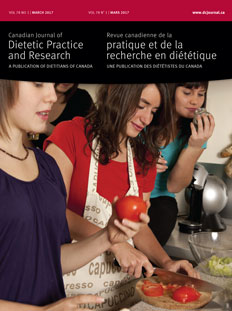Abstract
Purpose: To assess the type and quantity of foods children brought and consumed at school in the balanced school day (BSD), with two 20-minute eating periods, versus the traditional schedule (TS), with one 20-minute lunch.
Methods: Direct observation identified food items and amounts in BSD and TS lunches of grade 3 and 4 students (n = 321).
Results: The mean (SD) servings of foods packed in BSD lunches were significantly higher than the TS lunches for milk and alternatives (0.69 (0.70) vs 0.47 (0.49), P = 0.02), sugar-sweetened beverages (SSBs; 0.91 (1.24) vs 0.57 (0.99), P = 0.01), and snacks (2.74 (1.55) vs 2.24 (1.48), P < 0.01). Regardless of schedule, only 40.8% of students had vegetables packed in their lunch, whereas 92.8% had snacks. When comparing foods eaten, SSBs and snacks remained significantly higher in the BSD (0.75 (1.02) vs 0.48 (0.83), P = 0.03; 2.37 (1.44) vs 1.93 (1.36), P = 0.01, respectively). The proportion of children (%) whose consumption met one-third of Canada’s Food Guide recommendations for vegetables and fruit was low (27.5% BSD, 31.0% TS).
Conclusions: The BSD may have unintended negative consequences on the type and amount of foods packed in school lunches. Support for families should focus on encouraging more vegetables and fruit and fewer SSBs and snacks in packed lunches.
Résumé
Objectif : Évaluer le type et la quantité d’aliments que les enfants apportent et consomment à l’école durant la journée scolaire équilibrée (JSE), qui comprend deux périodes de 20 minutes pour manger, comparativement à l’horaire traditionnel (HT), qui comprend une période de dîner de 20 minutes.
Méthodes : Observation directe pour déterminer le type et la quantité d’aliments que consomment les enfants de 3e et de 4e année (n = 231) pour le dîner dans le cadre de la JSE et de l’HT.
Résultats : Le nombre moyen de portions (écart-type) dans les boîtes à lunch associé à la JSE était significativement plus élevé que celui des boîtes à lunch de l’HT pour la catégorie lait et substituts (0,69 (0,70) vs 0,47 (0,49), P = 0,02), les boissons sucrées (0,91 (1,24) vs 0,57 (0,99), P = 0,01) et les collations (2,74 (1,55) vs 2,24 (1,48), P < 0,01). Peu importe l’horaire, seulement 40,8 % des boîtes à lunch contenaient des légumes, alors que 92,8 % contenaient des collations. Lorsque l’on compare les aliments consommés, les boissons sucrées et les collations étaient significativement plus présentes pour la JSE (0,75 (1,02) vs 0,48 (0,83), P = 0,03; 2,37 (1,44) vs 1,93 (1,36), P = 0,01, respectivement). La proportion d’enfants (%) dont la consommation respectait un tiers des recommandations du Guide alimentaire canadien pour les légumes et les fruits était faible (27,5 % pour la JSE et 31 % pour l’HT).
Conclusions : La JSE pourrait entraîner des conséquences négatives non désirées sur le type et la quantité d’aliments contenus dans les boîtes à lunch. Le soutien aux familles devrait être axé sur l’augmentation de la quantité de légumes et de fruits et la diminution des boissons sucrées et des collations dans les boîtes à lunch.



